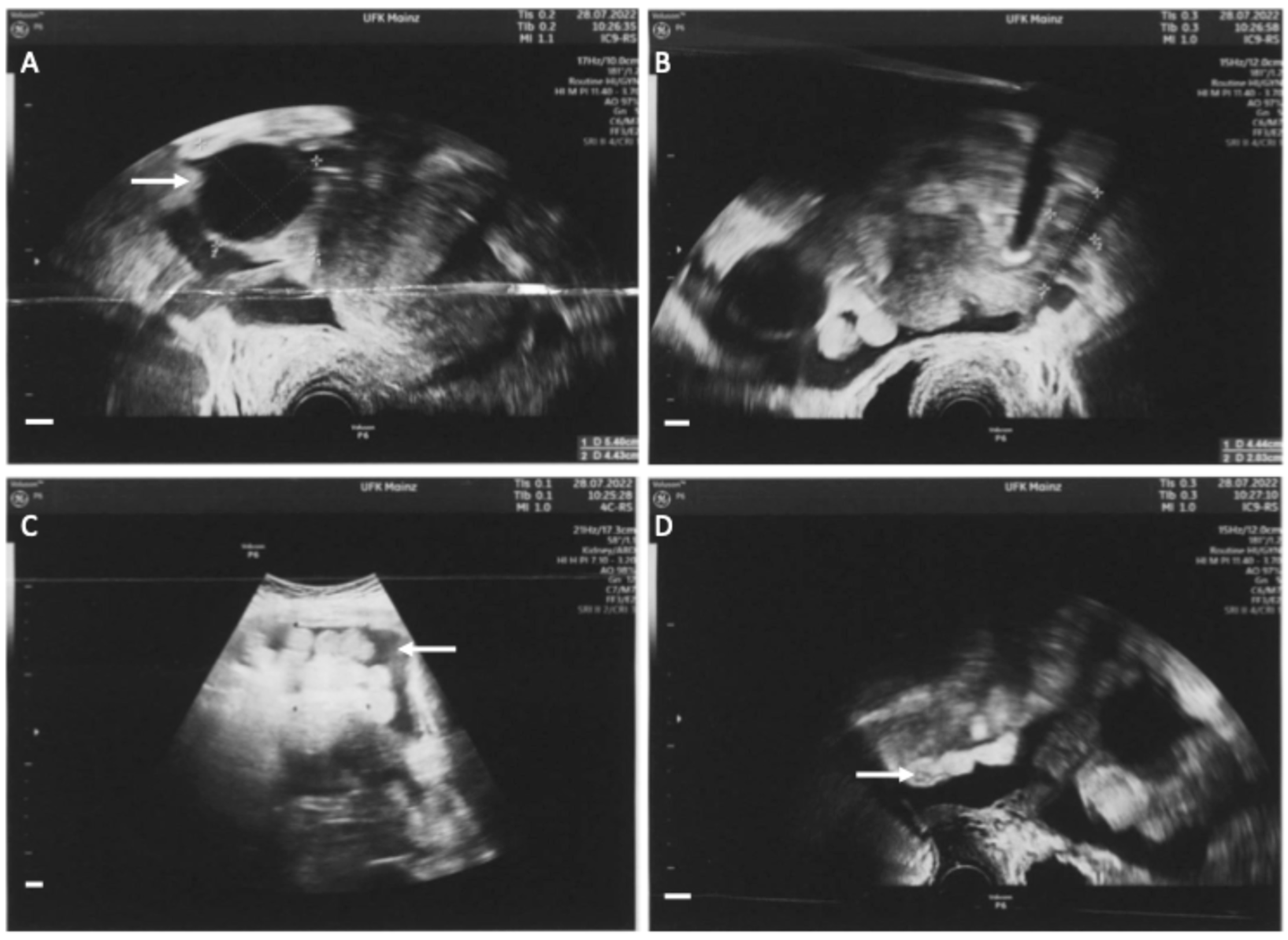Abdominal B-Cell Lymphoma Mimicking Ovarian Cancer
Abstract
Author Contributions
Funding
Institutional Review Board Statement
Informed Consent Statement
Data Availability Statement
Acknowledgments
Conflicts of Interest
Abbreviation
| R-CHOP | rituximab, cyclophosphamide, hydroxydaunorubicin, vincristine sulfate, prednisone |
References
- Rajendran, T.; Kini, J.R.; Prasad, K. Primary Ovarian Non-Hodgkin’s Lymphoma: An 18-year Retrospective Institutional Study and Review of Literature from India. Cureus 2023, 15, e40685. [Google Scholar] [CrossRef] [PubMed]
- Sung, Y.-W.; Lin, Y.-S.; Chen, Y.-T.; Yeh, L.-S. Non-Hodgkin’s B-cell lymphoma of the ovary: A case report and review of the literature. Taiwan. J. Obstet. Gynecol. 2022, 61, 539–543. [Google Scholar] [CrossRef] [PubMed]
- Senol, T.; Doger, E.; Kahramanoglu, I.; Geduk, A.; Kole, E.; Yucesoy, I.; Caliskan, E. Five Cases of Non-Hodgkin B-Cell Lymphoma of the Ovary. Case Rep. Obstet. Gynecol. 2014, 2014, 392758. [Google Scholar] [CrossRef] [PubMed]
- Leitlinienprogramm Onkologie (Deutsche Krebsgesellschaft DK A.). S3-Leitlinie Diagnostik, Therapie und Nachsorge Maligner Ovarialtumoren, Langversion 51 (AWMF-Registernummer: 032/035OL); Oncology Guideline Program of the Association of Scientific Medical Societies (AWMF), the German Cancer Society (DKG) and the German Cancer Aid Foundation (DKH): Berlin, Germany, 2024; Available online: https://www.leitlinienprogramm-onkologie.de/leitlinien/ovarialkarzinom (accessed on 25 October 2024).
- Armstrong, D.K.; Alvarez, R.D.; Bakkum-Gamez, J.N.; Barroilhet, L.; Behbakht, K.; Berchuck, A.; Chen, L.M.; Cristea, M.; DeRosa, M.; Eisenhauer, E.L.; et al. Ovarian Cancer, Version 2.2020, NCCN Clinical Practice Guidelines in Oncology. J. Natl. Compr. Canc. Netw. 2021, 19, 191–226. [Google Scholar] [CrossRef] [PubMed]
- Jung, D.; Schadmand-Fischer, S.; Hasenburg, A.; Schwab, R. #88 Abdominal B-cell lymphoma mimicking ovarian cancer. Int. J. Gynecol. Cancer 2023, 33, A245–A246. [Google Scholar]




Disclaimer/Publisher’s Note: The statements, opinions and data contained in all publications are solely those of the individual author(s) and contributor(s) and not of MDPI and/or the editor(s). MDPI and/or the editor(s) disclaim responsibility for any injury to people or property resulting from any ideas, methods, instructions or products referred to in the content. |
© 2024 by the authors. Licensee MDPI, Basel, Switzerland. This article is an open access article distributed under the terms and conditions of the Creative Commons Attribution (CC BY) license (https://creativecommons.org/licenses/by/4.0/).
Share and Cite
Jung, D.; Schiestl, L.J.; Schadmand-Fischer, S.; Schad, A.; Hasenburg, A.; Schwab, R. Abdominal B-Cell Lymphoma Mimicking Ovarian Cancer. Diagnostics 2024, 14, 2449. https://doi.org/10.3390/diagnostics14212449
Jung D, Schiestl LJ, Schadmand-Fischer S, Schad A, Hasenburg A, Schwab R. Abdominal B-Cell Lymphoma Mimicking Ovarian Cancer. Diagnostics. 2024; 14(21):2449. https://doi.org/10.3390/diagnostics14212449
Chicago/Turabian StyleJung, Dennis, Lina Judit Schiestl, Simin Schadmand-Fischer, Arno Schad, Annette Hasenburg, and Roxana Schwab. 2024. "Abdominal B-Cell Lymphoma Mimicking Ovarian Cancer" Diagnostics 14, no. 21: 2449. https://doi.org/10.3390/diagnostics14212449
APA StyleJung, D., Schiestl, L. J., Schadmand-Fischer, S., Schad, A., Hasenburg, A., & Schwab, R. (2024). Abdominal B-Cell Lymphoma Mimicking Ovarian Cancer. Diagnostics, 14(21), 2449. https://doi.org/10.3390/diagnostics14212449





